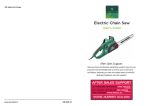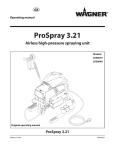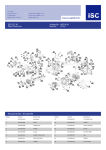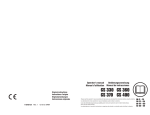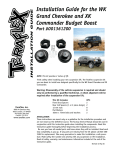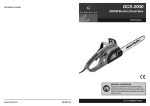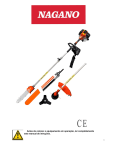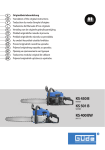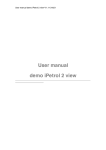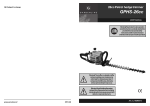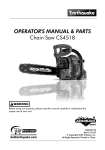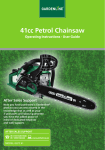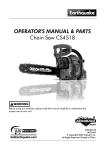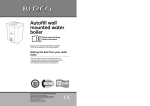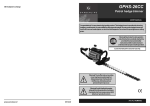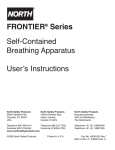Download 42cc Petrol Chain Saw
Transcript
42cc Petrol Chain Saw GB Subject to change GPCS-42CC PETROL CHAIN SAW USER’S MANUAL This product has been tested at a computed kickback angle (CKA) of no greater than 16.3 degrees. WARNING • PLEASE READ Beware of kickback. Hold chain saw firmly with both hands when using. For your own safety, please read and follow the safety precautions in this manual before attempting to operate your chain saw. Improper use can cause serious injury. www.servotool.nl GB-0702-01 Art. no. KZM6004 GB Exploded view GENERAL SAFETY RULES Meaning of symbols marked on the product Read the user manual before using the machine Whenever the machine is in use, safety goggles must be worn to safeguard against flying objects, as must ear protectors, such as a soundproof helmet, in order to protect the operator’s hearing. If the operator is working in an area where there is a risk of falling objects, a safety helmet must also be worn. Wear gloves to protect your hands Warning! Danger Beware of kickback! Hold chain saw firmly with both hands when using. Make Sure the Chain Brake® is disengaged! Pull Hand Guard/Chain Brake® back to run. Acoustic power level LWA accordance with directive 2000/14/EC Wear safety boots to protect agains electric shock WARNING! When using petrol tools, basic safety precautions, including the following, should always be followed to reduce the risk of serious personal injury and/or damage to the unit. Read all these instructions before operating this product and save these instructions. Get to know your chainsaw before putting it to use. Familiarize yourself with the safety features and know how to turn the saw off immediately in cases of emergency. Get used to the chainsaw by practising cutting small logs first before proceeding to main task. The use of a log cradle is recommended. 1. 02 DO NOT operate a chain saw with one hand! Serious injury to the operator, helpers, bystanders, or any combination of these persons may result from one-handed operation. A chain saw is intended for two-handed use. Gardenline Gardenline 31 GB GB Spare parts list GPCS 42cc Nr. Description Nr. Description Nr. Description 1 2 3 4 5 6 7 8 9 10 11 12 13 14 15 37 38 39 40 41 42 43 44 77 78 79 80 81 16 17 18 19 20 21 22 23 24 25 26 27 28 29 30 31 32 33 34 35 36 30 2. CAP, BEARING BEARING CRANK/ROD ASS'Y PISTON RING, PISTON ROLLER, PISTON PIN, PISTON RING CASE, CRANK SPARK PLUG CYLINDER RUBBER, ISOLATOR SPACER SCREW ISOLATOR, CARBURETOR SPRING WASHER SCREW SPACER CARBURETTOR AIR FILTER ASS/Y NUT SCREW HANDLE, LEFT, 348C GREEN TRIGGER, THROTTLE, 122C YELLOW THROTTLE LATCH, RELEASE, 122C YELLOW SPRING SCREW RUBBER HANDLE, RIGHT, 348C GREEN SWITCH WASHER SCREW HANDLE, FRONT, BLACK STARTER ASS'Y, BLACK+122C YELLOW NUT FLYWHEEL 45 46 47 48 49 50 51 52 53 54 55 56 57 58 59 60 61 62 63 64 65 66 67 68 69 70 71 72 73 74 75 76 SCREW WIRE ASS'Y IGNITION ASS'Y CONDUCTIVE PLATE OIL CAP ASS'Y, BLACK SPRING ASS'Y PRIMER FUEL CAP ASS'Y, BLACK SPRING SCREW FILTER HOUSING ASS'Y, 348C GREEN HOLDER, CABLE LEVER, CHOKE, 122C YELLOW HOLDER, CHOKE LEVEL SPRING CONNECTOR OIL PIPE PUMP ASS'Y SPACER BAFFLE BAFFLE MUFFLER ASS'Y SCREW CABLE, THROTTLE FUEL PIPE WOODRUFF KEY MESH FILTER, AIR SPIKED BUMPER SCREW SCREW SHROUD, 348C GREEN SCREW NUT FELT WORM CAP, ANTI-DUST SCREW SCREW 82 83 84 85 86 87 88 DRUM ASS'Y CLUTCH ASS'Y CAP, ANTI-DUST NUT BRAKE KIT ASS'Y, BLACK NUT 18" BAR, OREGON CHAIN, OREGON 91PJ WASHER SCREW WRENCH BAR SHEATH, 18" DO NOT operate a chain saw when you are fatigued, under the influence of drugs, alcohol or medication. 3. Use safety footwear, snug-fitting protective clothing, protective gloves, and eye, hearing and head protection devices. 4. Use caution when handling fuel. Move the chain saw at least 12 feet (4m) from the fueling point before starting the engine. 5. DO NOT allow other persons to be near when starting or cutting with the chain saw. Keep bystanders and animals out of the work area. 6. DO NOT start cutting until you have a clear work area, secure footing, and a planned retreat path from the falling tree. 7. Keep all parts of your body away from the saw chain when the engine is running. 8. Before you start the engine, make sure that the saw chain is not contacting anything. 9. Carry the chain saw with the engine stopped, the guide bar and saw chain to the rear, and the muffler away from your body. 10. DO NOT operate a chain saw that is damaged, improperly adjusted, or not completely and securely assembled. Be sure that the saw chain stops moving when the throttle control trigger is released. 11. Shut off the engine before setting the chain saw down. 12. Use extreme caution when cutting small size brush and saplings because slender material may catch the saw chain and be whipped toward you or pull you off balance. 13. When cutting a limb that is under tension, be alert for springback so that you will not be struck when the tension in the wood fibers is released. 14. Keep the handles dry, clean, and free of oil or fuel mixture. 15. Operate the chain saw only in well-ventilated areas. 16. DO NOT operate a chain saw in a tree unless you have been specifically trained to do so. 17. All chain saw service, other than the items listed in the user manual safety and maintenance instructions, should be performed by competent chain saw service personnel. 18. When transporting your chain saw, use the appropriate guide bar scabbard. 19. DO NOT operate your chain saw near or around flammable liquids or gases whether in or out of doors. An explosion and/or fire may result. 20. Do not fill fuel tank, oil tank or lubricate when the engine is running. 21. USE THE RIGHT TOOL: Cut wood only. Do not use the chain saw for purposes for which it was not intended. For example, do not use the chain saw for cutting plastic, masonry, or nonbuilding materials. 22. Never operate a chain saw on a ladder 23. Keep hair tied back safely 24. Product suitable for adult use only. KEEP AWAY FROM CHILDREN 25. Warning: working with petrol is dangerous. Fumes may linger for some distance. NO SMOKING! NO NAKED FLAMES! 26. Never use in wet conditions or on wet wood Note: This appendix is intended primarily for the consumer or occasional user. These models are intended for infrequent use by homeowners, cottagers, and campers, and for such general applications as clearing, pruning, cutting firewood, etc. They are not intended for prolonged use. If the intended use involves prolonged periods of operation, this may cause circulatory problems in the user’s hands due to vibration. Gardenline Gardenline 03 GB GB KICKBACK SAFETY PRECAUTIONS CE DECLARATION OF CONFORMITY (GB) We declare under our sole responsibility that this product, Kickback may occur when the nose or tip of the guide bar touches an object, or when the wood closes in and pinches the saw chain in the cut. If the bar tip contacts, it may cause a lightning-fast reverse reaction, kicking the guide bar up and back towards the operator. Pinching the saw chain along the top of the guide bar may push the guide bar rapidly back towards the operator. Either of these reactions may cause you to lose control of the saw, which could result in serious personal injury. Do not rely exclusively upon the safety devices built into your saw. As a chain saw user, you should take several steps to keep your cutting jobs free from accident or injury. 1. 2. 3. 4. 5. 6. 7. With a basic understanding of kickback, you can reduce or eliminate the element of surprise. Sudden surprise contributes to accidents. Keep a good firm grip on the saw with both hands, the right hand on the rear handle, and the left hand on the front handle, when the engine is running. Use a firm grip with thumbs and fingers encircling the chain saw handles. A firm grip will help you reduce kickback and maintain control of the saw. Don’t let go. Make sure that the area in which you are cutting is free from obstructions. Do not let the nose of the guide bar contact a log, branch, or any other obstruction which could be hit while you are operating the saw. Cut at high engine speeds. Do not overreach or cut above shoulder height. Follow manufacturer’s sharpening and maintenance instructions for the saw chain. Only use replacement bars and chains specified by the manufacturer or the equivalent. GPCS-42cc Petrol Chain Saw is in conformity with the following standards or standardized documents: EN ISO 11681-1:2004 in accordance with the regulations: 98/37EEC, 89/336/EEC, 2000/14/EC from 01-06-2006 ZWOLLE NL J.A. Bakker - van Ingen CEO Ferm BV J. Lodewijk Quality Manager Ferm Global It is our policy to continuously improve our products and we therefore reserve the right to change the product specification without prior notice. NOTE: Low-kickback saw chain is chain that has met the kickback performance. IMPORTANT SAFETY Ferm BV • Lingenstraat 6 • 8028 PM Zwolle • The Netherlands Your Gardenline Chain Saw is provided with a safety label located on the chain brake lever/hand guard. This label, along with the safety instructions on these pages, should be carefully read before attempting to operate this unit. Warning: RED Used to warn that an unsafe procedure should not be performed. HOW TO READ SYMBOLS AND COLORS (FIG. 1) GREEN RECOMMENDED Recommended cutting procedure. WARNING 1. Beware of kick back. 2. Do not attempt to hold saw with one hand. 3. Avoid bar nose contact. 04 Gardenline Gardenline 29 GB GB cutting efficiency, shorten saw chain life, cause rapid dulling of chain, and lead to excessive wear of bar from overheating. Too little oil is evidenced by smoke or bar discoloration. CHAIN SHARPENING: Chain sharpening requires special tools to ensure that cutters are sharpened at the correct angle and depth. For the inexperienced chain saw user, we recommend that the saw chain be professionally sharpened by the nearest professional Service Center. If you feel comfortable sharpening your own saw chain, special tools are available from the professional Service Center. STORAGE Keep the machine in a well-ventilated, cool and dry room when it is not to be used for some time. The fuel reservoir should be empty. Always store the machine out of the reach of children. Fig. 1 RECOMMENDED 4. Hold Saw properly with both hands. • DANGER! BEWARE OF KICKBACK! Warning: Kickback can lead to dangerous loss of control of the chain saw and result in serious or fatal injury to the saw operator or to anyone standing close by. Always be alert. Rotational kickback and pinch-kickback are major chain saw operational dangers and the leading cause of most accidents. A B A A A B C Fig. 2A Fig. 2B BEWARE OF: ROTATIONAL KICKBACK (Fig. 2A) A = Kickback path B = Kickback reaction zone THE PUSH (PINCH KICKBACK) AND PULL REACTIONS (Fig. 2B) A = Pull B = Solid objects C = Push KICKBACK may occur when the NOSE or TIP of the guide bar touches an object, or when wood closes in and pinches the saw chain in the cut. Tip contact in some cases may cause a lightning-fast reverse reaction, kicking the guide bar up and 28 Gardenline Gardenline 05 GB GB back toward the operator. PINCHING the saw chain along the BOTTOM of the guide bar may PULL the saw forward away from the operator. PINCHING the saw chain along the TOP of the guide bar may PUSH the guide bar rapidly back toward the operator. Any of these reactions may cause you to lose control of the saw, which could result in serious personal injury. Warning: Proper adjustment of the depth gauge is as important as proper sharpening of the chain. Warning: Never mount a new chain on a worn sprocket or self-aligning ring. GENERAL INFORMATION Fig. 24 Fig. 25 BAR WEAR - Turn guide bar frequently at regular intervals (for example, after 5 hours of use), to ensure even wear on top and bottom of bar. OIL PASSAGES - Oil passages on the bar should be cleaned to ensure proper lubrication of the bar and chain during operation. NOTE: The condition of the oil passages can be easily checked. If the passages are clear, the chain will automatically give off a spray of oil within seconds of starting the saw. Your saw is equipped with an automatic oiler system. CHAIN MAINTENANCE CHAIN TENSION: Check the chain tension frequently and adjust as often as necessary to keep the chain snug on the bar, but loose enough to be pulled around by hand. BREAKING IN A NEW SAW CHAIN: A new chain and bar will need chain readjustment after as few as 5 cuts. This is normal during the break-in period, and the interval between future adjustments will begin to lengthen quickly. CHAIN LUBRICATION: Always make sure the automatic oiler system is working properly. Keep the oil tank filled with Chain, Bar and Sprocket Oil. Adequate lubrication of the bar and chain during cutting operations is essential to minimize friction with the guide bar. Warning: Never have more than 3 links removed from a loop of chain. This could cause damage to the sprocket. Never starve the bar and chain of lubricating oil. Running the saw dry or with too little oil will decrease 06 Gardenline Gardenline 27 GB GB Warning: Always wear protective gloves during maintenance operations. Do not carry out maintenance when the engine is hot. 1. 2. 3. 4. 5. Sharpen the chain using protective gloves and a round file of ø5/32” (4mm). 6. 7. 8. 9. 10. 11. 12. 13. 14. 15. Spark Plug Air Cleaner Cover Primer Bulb Safety Trigger Oil Tank cap Starter Cover Fuel Tank Cap Rear Handle / Boot Loop 16. 17. 18. 19. 20. 21. 22. 23. ON-OFF Switch Choke Lever Bar Retaining Nut Throttle Trigger Chain Catcher Muffler Shield Spiked Bumper Scabbard SAFETY FEATURES Fig. 21 Always sharpen the cutters only with outward strokes (Fig. 22) observing the values given in Fig. 21. After sharpening, the cutting links must all have the same width and length. After every 3-4 times the cutters have been sharpened you need to check the height of the depth gauges and, if necessary, lower them using the flat file and template supplied optional, then round off the front corner. (Fig. 23) Familiarise yourself with all the safety features before use. Numbers preceding the descriptions correspond with the numbers on preceding page to help you locate the safety feature. 2 4 Warning: Proper adjustment of the depth gauge is as important as proper sharpening of the chain. 5 GUIDE BAR - The bar should be reversed every 8 working hours to ensure uniform wear. 5 10 11 20 21 22 Fig. 22 Guide Bar Saw chain Saw Chain Adjustment Screw Spark Arrester Screen Chain Brake Lever / Hand Guard Front Handle Starter Handle Fig. 23 LOW KICKBACK SAW CHAIN helps significantly reduce kickback, or the intensity of kickback, due to specially designed depth gauges and guard links. SPARK ARRESTER SCREEN retains carbon and other flammable particles over 0.023 inches (0.6mm) in size from engine exhaust flow. Compliance with local, state and federal laws and/or regulations governing the use of a spark arrester screen is the user’s responsibility. See Safety Precautions for additional information. CHAIN BRAKE LEVER / HAND GUARD protects the operator’s left hand in the event it slips off the front handle while saw is running. CHAIN BRAKE is a safety feature designed to reduce the possibility of injury due to kickback by stopping a moving saw chain in milliseconds. It is activated by the CHAIN BRAKE lever. STOP SWITCH immediately stops the engine when tripped. Stop switch must be pushed to ON position to start or restart engine. SAFETY TRIGGER prevents accidental acceleration of the engine. Throttle trigger (19) cannot be squeezed unless the safety latch is depressed. CHAIN CATCHER reduces the danger of injury in the event saw chain breaks or derails during operation. The chain catcher is designed to intercept a whipping chain. MUFFLER SHIELD / CLUTCH COVER helps prevent hands and combustible materials from making contact with a hot muffler. SPIKED BUMPER The spiked bumper is used for your personal safety and ease of cutting. Spiked bumper will increase your stability while performing vertical cutting. NOTE: Study your saw and be familiar with its parts. Warning: A sharp chain produces well-defined chips. When your chain starts to produce sawdust, it is time to sharpen. Keep the bar groove and lubrication hole clean using a bar groove cleaner (optional). (Fig. 24) Check the bar rails frequently for wear and, if necessary, remove the burs and square-up the rails using a flat file. (Fig. 25) 26 Gardenline Gardenline 07 GB GB SPECIFICATIONS Engine Displacement Maximum Shaft Brake Power The usable cutting lengths Bar Length Chain Pitch Chain Gauge Idle Speed Recommended max. speed with cutting attachment Fuel Capacity Oil Capacity Drive Sprocket Clutch Low Kick Back Chain Low Kick-back Chain Type Type of Guide Bar Net Weight (Without guide bar and chain) Net Weight Sound pressure level Sound power level Mean braking time at racing speed Vibration Fuel consumption Lubrication of the sprocket tip is recommended after 10 hours of use or once a week, which ever occurs first. Always thoroughly clean guide bar sprocket tip before lubrication. 42cm3 1.7 kW/2.28HP 39cm 45cm .9.53mm (3/8”) 1.27mm (0.05”) 3500 min-1 12,700 min-1 400cm3 220cm3 6 Teeth Y Y 91PJ060 180SDEA095 5.59 kg 6.5 kg 112 dB(A) 112 dB(A) 0.12s 12 m/s2 800 g/kWh TOOLS FOR LUBRICATION: The Lube Gun (optional) is recommended for applying grease to the guide bar sprocket tip. The Lube Gun is equipped with a needle nose tip which is necessary for the efficient application of grease to the sprocket tip. Warning: Wear heavy duty work gloves when handling the bar and chain. TO LUBRICATE SPROCKET TIP: 1. Press the STOP switch down. NOTE: It is not necessary to remove the saw chain to lubricate the guide bar sprocket tip. Lubrication can be done on the job. 2. 3. 4. * Chain brake/Hand guard * Hard chrome cylinder * Electronic Ignition * Primer Carburettor * Safety Trigger-throttle Latch * Three position choke * Trouble free performance * Automatic chain oiler * Anti-Vibration * Oregon Blade and Chain Clean the guide bar sprocket tip. Using the Lube Gun (optional), insert needle nose into the lubrication hole and inject grease until it appears at outside edge of sprocket tip (Fig. 20). Rotate saw chain by hand. Repeat lubrication procedure until the entire sprocket tip has been greased. Fig. 20 GUIDE BAR MAINTENANCE: Most guide bar problems can be prevented merely by keeping the chain saw well maintained. Insufficient guide bar lubrication and operating the saw with chain that is TOO TIGHT will contribute to rapid bar wear. To help minimize bar wear, the following guide bar maintenance procedures are recommended. ASSEMBLY INSTRUCTIONS CHAIN SHARPENING: Chain sharpening requires special tools to ensure that cutters are sharpened at the correct angle and depth. For the inexperienced chain saw user, we recommend that the saw chain be professionally sharpened by the nearest professional Service Center. If you feel comfortable sharpening your own saw chain, special tools are available from the professional Service Center. TOOLS FOR ASSEMBLY You will need these tools to assemble your chain saw: 1. Combination wrench-screwdriver (contained in your user’s kit). 2. Heavy duty work gloves (user supplied). CHAIN SHARPENING - The pitch of the chain (Fig. 21) is 3/8” LoPro x .050”. 08 Gardenline Gardenline 25 GB GB STORING A CHAIN SAW Storing a chain saw for longer than 30 days requires storage maintenance. Unless the storage instructions are followed, fuel remaining in the carburettor will evaporate, leaving gum-like deposits. This could lead to difficult starting and result in costly repairs. Caution: Never store a chain saw for longer than 30 days without performing the following procedures. 1. 2. 3. 4. 5. Remove the fuel tank cap slowly to release any pressure in tank. Carefully drain the fuel tank. Start the engine and let it run until the unit stops to remove fuel from carburettor. Allow the engine to cool (approx. 5 minutes). Using a spark plug wrench, remove the spark plug. Pour 1 teaspoon of clean 2-cycle oil into the combustion chamber. Pull starter rope slowly several times to coat internal components. Replace spark plug. (Fig. 19) ASSEMBLY REQUIREMENTS Warning: DO NOT start saw engine until unit is properly prepared. Your new chain saw will require adjustment of chain, filling the fuel tank with correct fuel mixture and filling the oil tank with lubricating oil before the unit is ready for operation. Read the entire user manual before attempting to operate your unit. Pay particular attention to all safety precautions. Your user manual is both a reference guide and handbook provided to furnish you with general information to assemble, operate and maintain your saw. GUIDE BAR / SAW CHAIN / CLUTCH COVER INSTALLATION Warning: Always wear protective gloves when handling chain. NOTE: Store the unit in a dry place and away from possible sources of ignition such as a furnace, gas hot water heater, gas dryer, etc. TO INSTALL GUIDE BAR: To ensure the bar and chain receive oil, ONLY USE THE ORIGINAL STYLE BAR with the oil passage hole (A) as illustrated above. (Fig. 3A) 1. 2. Make sure the CHAIN BRAKE lever is pulled back into the DISENGAGED position (Fig. 3B) Remove the bar retaining nut (B) and the chain break cover screw (which is at the base towards the handle )(H). Remove the CHAIN BRAKE cover (C) by pulling straight out, some force may be required. (Fig. 3C). Note: Discard the two plastic washers. They are only used for shipping the chain saw. 3. Fig. 19 REMOVING A UNIT FROM STORAGE 1. Remove spark plug. 2. Pull starter rope briskly to clear excess oil from combustion chamber. 3. Clean and gap spark plug or install a new spark plug with proper gap. 4. Prepare unit for operation. 5. Fill fuel tank with proper fuel / oil mixture. See Fuel and Lubrication Section. 4. Using a flat headed screwdriver, turn the adjustment screw (D) ANTICLOCKWISE until the TANG (E) (projecting prong) is to the end of its travel (Fig. 3D). Place the slotted end of the guide bar over the bar bolt (F). Slide guide bar behind clutch drum (G) until the guide bar stops (Fig. 3E). GUIDE BAR MAINTENANCE Frequent lubrication of the guide bar (railed bar which supports and carries the saw chain) sprocket tip is required. Proper maintenance of the guide bar, as explained in this section, is essential to keep your saw in good working condition. Fig. 3A SPROCKET TIP LUBRICATION: Fig. 3B Caution: The sprocket tip on your new saw has been pre-lubricated at the factory. Failure to lubricate the guide bar sprocket tip as explained below will result in poor performance and seizure, voiding the manufacturer’s warranty. 24 Gardenline Gardenline 09 GB GB 1. 2. 3. 4. Fig. 3C Remove the 2 bolts (A) and pull muffler out. (Figure 17A). Remove the 2 screws that hold the cover (C) . (Figure 17B) Discard the used spark arrester screen (D) and replace it with a new one. Reasemble the muffler components and install the muffler to the cylinder. Tighten securely. Fig. 3D Fig. 17A Fig. 3E SPARK PLUG TO INSTALL SAW CHAIN: Always wear heavy duty gloves when handling saw chain or making saw chain adjustments. 1. Spread chain out in a loop with cutting edges (A) pointing CLOCKWISE around loop (Fig. 4A). 2. Slip the chain around the sprocket (B) behind the clutch (C). Make sure the links fit between the sprocket teeth (Fig. 4B). 3. Guide the drive links into the groove (D) and around the end of the bar (Fig. 4B). NOTE: For efficient operation of saw engine, spark plug must be kept clean and properly gapped. 1. 2. 3. 4. 5. NOTE: The saw chain may droop slightly on the lower part of bar. This is normal. 4. 5. Fig. 17B Push STOP switch down. Remove the top cover (A) by loosening the cover retaining screws. Cover will lift off. (Fig. 18A) Disconnect the wire connector (B) from the spark plug (C) by pulling and twisting at the same time (Fig. 18B). Remove spark plug with spark plug socket wrench. DO NOT USE ANY OTHER TOOL. Reinstall a new spark plug, gapped at .635mm. Pull guide bar forward until chain is snug (fig. 4B*). Ensure all drive links are in the bar groove. Install the clutch cover making sure the tang is positioned in the lower hole in the guide bar. Make sure the chain does not slip off of the bar. Install the bar retaining nut hand tight and the chain break cover screw (H) and follow tension adjustment instructions in Section Saw Chain Tension Adjustment. Make sure when refitting that the chain break is disengaged. NOTE: The guide bar retaining nuts are installed only hand tight at this point because saw chain adjustment is required. Follow instructions in Section Saw Chain Tension Adjustment. Fig. 18A Fig. 18B CARBURETTOR ADJUSTMENT The carburettor was pre-set at the factory for optimum performance. If further adjustments are necessary, please take your unit to the nearest qualified service technician. Fig. 4A 10 Fig. 4B Gardenline Gardenline 23 GB GB SAW CHAIN TENSION ADJUSTMENT Proper tension of saw chain is extremely important and must be checked before starting, as well as during any cutting operation. Taking the time to make needed adjustments to the saw chain will result in improved cutting performance and prolonged chain life. Warning: Always wear heavy duty gloves when handling saw chain or making saw chain adjustments. Fig. 15A Fig. 15B FUEL FILTER Caution: Never operate your saw without a fuel filter. The fuel filter should be replaced after each 20 hours of use. Drain fuel tank completely before changing filter. 1. 2. 3. Remove the fuel tank cap. Bend a piece of soft wire. Reach into fuel tank opening and hook fuel line. Carefully pull the fuel line toward the opening until you can reach it with your fingers. NOTE: Do not pull hose completely out of tank. 4. 5. 6. 7. Lift filter (A) out of tank (Fig. 16). Pull filter off with a twisting motion. Discard filter. Install new filter. Insert end of filter into tank opening. Make sure filter sits in bottom corner of tank. Use a long screwdriver to aid in filter placement if necessary. Fill tank with fresh fuel / oil mixture. See Section Fuel and Lubrication. Install fuel cap. TO ADJUST SAW CHAIN: 1. Hold nose of guide bar up and turn adjustment screw (A) CLOCKWISE to increase chain tension. Turning screw ANTICLOCKWISE will decrease amount of tension on chain. Ensure the chain fits snugly all the way around the guide bar (Fig. 5). 2. After making adjustment, and while still holding nose of bar in the uppermost position, tighten the bar retaining nut securely. Chain has proper tension when it has a snug fit all around and can be pulled around by gloved hand. NOTE: If chain is difficult to rotate on guide bar or if it binds, too much tension has been applied. This requires minor adjustment as follows: A. Loosen the bar retaining nut so they are finger tight. Decrease tension by turning the bar adjustment screw ANTICLOCKWISE slowly. Move chain back and forth on bar. Continue to adjust until chain rotates freely, but fits snugly. Increase tension by turning bar adjustment screw CLOCKWISE. B. When saw chain has proper tension, hold nose of bar in the uppermost position and tighten the 2 bar retaining nuts securely. Caution: A new saw chain stretches, requiring adjustment after as few as 5 cuts. This is normal with a new chain, and the interval between future adjustments will lengthen quickly. Fig. 5 Fig. 16 Caution: If saw chain is TOO LOOSE or TOO TIGHT, the sprocket, bar, chain, and crankshaft bearings will wear more rapidly. Study Fig. 6 for information concerning correct cold tension (A), correct warm tension (B), and as a guide for when saw chain needs adjustment (C). SPARK ARRESTER SCREEN NOTE: A clogged spark arrester screen will dramatically reduce engine performance. 22 Gardenline Gardenline 11 GB GB MAINTENANCE INSTRUCTIONS All chain saw service, other than items listed here in your user manual maintenance instructions, should be performed by a professional. PREVENTIVE MAINTENANCE A good preventive maintenance program of regular inspection and care will increase life and improve performance of your Gardenline chain saw. This maintenance checklist is a guide for such a program. Cleaning, adjustment, and parts replacement may be required, under certain condit Fig. 6 CHAIN BRAKE MECHANICAL TEST Your chain saw is equipped with a Chain brake that reduces possibility of injury due to kickback. The brake is activated if pressure is applied against brake lever when, as in the event of kickback, operator’s hand strikes the lever. When the brake is actuated, chain movement stops abruptly. Warning: The purpose of the chain brake is to reduce the possibility of injury due to kickback; however, it cannot provide the intended measure of protection if the saw is operated carelessly. Always test the chain brake before using your saw and periodically while carrying out the task. To Test Chain Brake: 1. The Chain brake is DISENGAGED (chain can move) when BRAKE LEVER IS PULLED BACK AND LOCKED (Fig. 7A). 2. The Chain brake is ENGAGED (chain is stopped) when brake lever is in forward position. You should not be able to move chain (Fig. 7B). NOTE: The brake lever should snap into both positions. If strong resistance is felt, or lever does not move into either position, do not use your saw. Take it immediately to a professional Service Center for repair. AIR FILTER Caution: Never operate saw without the air filter. Dust and dirt will be drawn into engine and damage it. Keep the air filter clean! TO CLEAN AIR FILTER: 1. Remove the top cover (A) by loosening the cover retaining screws. Cover will lift off. (Fig. 15A) 2. Lift the air filter (B) out of air-box (C) (Fig. 15B). 3. Clean air filter. Wash filter in clean, warm, soapy water. Rinse in clear, cool water. Air dry completely. NOTE: It is advisable to have a supply of spare filters. 4. Fig. 7A Install air filter. Install engine / air filter cover. Make sure cover fits properly. Tighten the cover retaining screws securely. Fig. 7B Warning: Never perform maintenance when the engine is hot, to avoid any chance of burning hands or fingers. FUEL AND LUBRICATION Safety first: Flammable materials. Fill chainsaw at least 4 metres away from work area. No smoking! 12 Gardenline Gardenline 21 GB GB off is not resting on the ground. If the log is supported at both ends and you must cut in the middle, make a downward cut halfway through the log and then make the undercut. This will prevent the log from pinching the bar and chain. Be careful that the chain does not cut into the ground when bucking as this causes rapid dulling of the chain. When bucking on a slope, always stand on the uphill side. D NL 1. F 2. 3. E I VERTICAL CUTTING: A. Hold the saw firmly with both hands and keep the saw to the right of your body while cutting. B. Keep the left arm as straight as possible. C. Keep weight on both feet. SF N NL F Warning: If 2-cycle lubricant other than Gardenline Custom Lubricant is to be used, it must be a premium grade oil for 2-cycle air cooled engines mixed at a 40:1 ratio. Do not use any 2-cycle oil product with a recommended mixing ratio of 100:1. If insufficient lubrication is the cause of engine damage, it voids the manufacturer’s engine warranty for that occurrence. E P MIXING FUEL Mix fuel with oil in an approved container. Use mixing table for correct ratio of fuel to oil. Shake container to ensure thorough mix. BUCKING USING A SAWHORSE For personal safety and ease of cutting, the correct position for vertical bucking is essential (Fig. 14). S D Warning: Never use straight petrol in your unit. This will cause permanent engine damage and void the manufacturer’s warranty for that product. Never use a fuel mixture that has been stored for over 90 days. Log supported along entire length: Cut from top (overbuck), being careful to avoid cutting into the ground (Fig. 13A). Log supported on 1 end: First, cut from bottom (underbuck) 1/3 diameter of log to avoid splintering. Second, cut from above (overbuck) to meet first cut and avoid pinching (Fig. 13B). Log supported on both ends: First, overbuck 1/3 diameter of log to avoid splintering. Second, underbuck to meet first cut and avoid pinching (Fig. 13C). NOTE: The best way to hold a log while bucking is to use a sawhorse. When this is not possible, the log should be raised and supported by the limb stumps or by using supporting logs. Be sure the log being cut is securely supported. P FUEL Use regular grade unleaded petrol mixed with 40:1 custom 2-cycle engine oil for best results. Use mixing ratios in Section FUEL MIXING TABLE. I Warning: Lack of lubrication voids engine warranty. S SF Fuel and Lubrication N Caution: While the saw is cutting, be sure the chain and bar are being properly lubricated. DK H DK Petrol and Oil Mix 40:1 H Oil Only Fuel Mixing Table CZ CZ SL SL PL PL RU Fig. 14 GR 20 RU RECOMMENDED FUELS Some conventional petrols are being blended with oxygenates such as alcohol or an ether compound to meet clean air standards. Your engine is designed to operate satisfactorily on any petrol intended for automotive use including oxygenated petrols. Gardenline Gardenline GR 13 GB GB CHAIN AND BAR LUBRICATION (NOT SUPPLIED) Always refill the chain oil tank each time the fuel tank is refilled. We recommend using oil which contains additives to reduce friction and wear and to assist in the prevention of pitch formation on the bar and chain. Seek the advice of an authorised service centre for correct lubricant. D NL D NL OPERATION F F Always use in accordance with manufacturers instructions. Fig. 11C ENGINE PRE-START CHECKS 1. Fill the fuel tank (A) with correct fuel mixture. (Fig. 8) 2. Fill the oil tank (B) with correct chain and bar oil (Fig. 8) 3. Be certain the chain brake is disengaged (C) before starting unit (Fig. 8) E P Warning: As the felling cut gets close to the hinge, the tree should begin to fall. When tree begins to fall, remove saw from cut, stop engine, put chain saw down, and leave area along retreat path (Fig. 11A). E P LIMBING Limbing a tree is the process of removing the branches from a fallen tree. Do not remove supporting limbs (A) until after the log is bucked (cut) into lengths (Fig. 12). Branches under tension should be cut from the bottom up to avoid binding the chain saw. TO START ENGINE 1. Press ON/OFF switch to the ON (I) position for starting. (Fig. 9A) 2. Pull the choke (A) out as far as it will go until the choke stays out. (Fig. 9B) I Fig.11D I Warning: Never start or operate the saw unless the bar and chain are properly installed. S S Warning: Never cut tree limbs while standing on tree trunk. SF 4. 3. Push the primer bulb (B) 10 times (Fig. 9C) Place saw on a firm, flat surface. Hold saw firmly as shown. Pull starter rapidly 4 times. Beware of moving chain. (Fig. 9D) SF N N NOTE: If the engine sounds as if it is trying to start before 4 th pull, stop pulling and immediately proceed to the next step. DK DK 5. 6. 7. 8. H Move choke lever (G) in completely. (Fig. 9E) Hold saw firmly and pull starter rapidly 4 times. Engine should start. Warm up for 10 seconds. Depress and release trigger (H) for idle (Fig. 9F) If engine failed to start, repeat these instructions. H Fig. 12 Fig. 13A CZ CZ SL SL PL PL RU FIg. 8 Fig. 13B Fig. 9A Fig. 13C RU BUCKING Bucking is cutting a fallen log into lengths. Make sure you have a good footing and stand uphill of the log when cutting on sloping ground. If possible, the log should be supported so that the end to be cut GR 14 Gardenline Gardenline GR 19 GB GB Warning: Do not cut down a tree during high or changing winds or if there is a danger to property. Consult a tree professional. Do not cut down a tree if there is a danger of striking utility wires; notify the utility company before making any cuts. GENERAL GUIDELINES FOR FELLING TREES: Normally felling consists of 2 main cutting operations, notching (C) and making the felling cut (D). Start making the upper notch cut (C) on the side of the tree facing the felling direction (E). Be sure you don t make the lower cut too deep into the trunk. The notch (C) should be deep enough to create a hinge (F) of sufficient width and strength. The notch should be wide enough to direct the fall of the tree for as long as possible. Never saw completely through the trunk. Always leave a hinge. A FIg. 9B Fig. 9C Warning: Never walk in front of a tree that has been notched. Make the felling cut (D) from the other side of the tree and 1.5 - 2.0 inches (3-5 cm) above the edge of the notch (C) (Fig. 11B) G FIg. 9D Fig. 9E FIg. 9F Fig. 9G Fig. 11B The hinge guides the tree. If the trunk is completely cut through, control over the felling direction is lost. Insert a wedge or felling lever in the cut well before the tree becomes unstable and starts to move. This will prevent the guidebar from binding in the felling cut if you have misjudged the falling direction. Make sure no bystanders have entered the range of the falling tree before you push it over. Warning: Before making the final cut, always recheck the area for bystanders, animals or obstacles. FELLING CUT: 1. Use wooden or plastic wedges (A) to prevent binding the bar or chain (B) in the cut. Wedges also control felling (Fig. 11C). 2. When diameter of wood being cut is greater than the bar length, make 2 cuts as shown (Fig. 11D). 18 Gardenline WARNING: Only start the machine as the person shows in the figure (9D). Always follow the next steps before start sawing! • • • Always place the machine on the ground to avoid the machine falling during starting. When the engine is started, depress and release the trigger: now the stick (throttle latch) on the main switch (throttle trigger) is released. Now the saw turns off automatically ones the finger is taken off the switch. RE-STARTING A WARM ENGINE 1. Make sure the switch is in the ON position. 2. Pull the starter rope rapidly 4 times. The engine should start. 3. If unable to start engine, please follow engine PRE-START CHECKS procedure to cold start engine. Gardenline 15 GB GB TO STOP ENGINE 1. Release trigger and allow engine to return to idle speed. 2. Press STOP switch down to stop engine. (Fig. 9G) overheating. Too little oil is evidenced by smoke, bar discoloration or pitch build-up. NOTE: For emergency stopping, simply activate chain brake and move STOP switch down. CHAIN BRAKE OPERATIONAL TEST Test the chain brake periodically to ensure proper function. Perform a chain brake test prior to initial cutting, following extensive cutting, and definitely following any Chain brake service. TEST CHAIN BRAKE AS FOLLOWS (Fig. 10) : 1. Place saw on a clear, firm, flat surface. 2. Start engine. 3. Grasp the rear handle (A) with your right hand. 4. With your left hand, hold the front handle (B) [not chain brake lever (C)] firmly. AUTOMATIC OILER Your chain saw is equipped with an automatic gear driven oiler system. The oiler automatically delivers the proper amount of oil to the bar and chain. As the engine speed increases, so does the oil flow to the bar pad. There is no flow adjustment. The oil reservoir will run out at approximately the same time as the fuel supply runs out. GENERAL CUTTING INSTRUCTIONS Warning: Activate the chain brake slowly and deliberately. Keep the chain from touching anything; don t let the saw tip forward. 5. 6. NOTE: Saw chain stretches during use, particularly when it is new, and it will occasionally be necessary to adjust and tighten it. New chain will require adjustment after about 5 minutes of operation. Squeeze the throttle trigger to 1/3 throttle, then immediately activate the chain brake lever (C). Chain should stop abruptly. When it does, immediately release the throttle trigger. FELLING Felling is the term for cutting down a tree. Small trees up to 6-7 inches (15-18cm) in diameter are usually cut in a single cut. Larger trees require notch cuts. Notch cuts determine the direction the tree will fall. FELLING A TREE: WARNING: Never force the job and never force the chainsaw. Warning: A retreat path (A) should be planned and cleared as necessary before cuts are started. The retreat path should extend back and diagonally to the rear of the expected line of fall, as illustrated in Fig. 11A Warning: If chain does not stop, turn engine off and take your unit to the nearest Gardenline Authorized Service Center for service. 7. Caution: If felling a tree on sloping ground, the chain saw operator should keep on the uphill side of the terrain, as the tree is likely to roll or slide downhill after it is felled. If chain brake functions properly, turn the engine off and return the chain brake to the DISENGAGED position. Make a number of smaller cuts if necessary rather than one large forced cut. NOTE: Direction of fall (B) is controlled by the notching cut. Before any cuts are made, consider the location of larger branches and natural lean of the tree to determine the way the tree will fall. Fig. 10 SAW CHAIN / BAR LUBRICATION Adequate lubrication of the saw chain is essential at all times to minimize friction with the guide bar. Never starve the bar and chain of oil. Running the saw with too little oil will decrease cutting efficiency, shorten saw chain life, cause rapid dulling of chain, and cause excessive wear of bar from 16 Gardenline Fig. 11A Gardenline 17
















